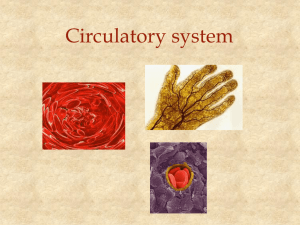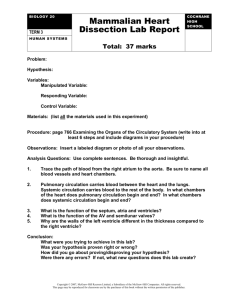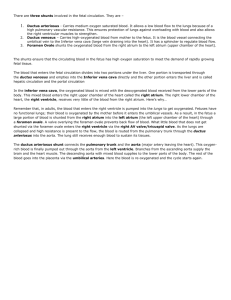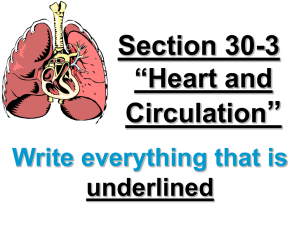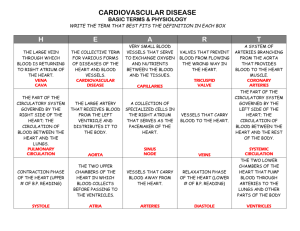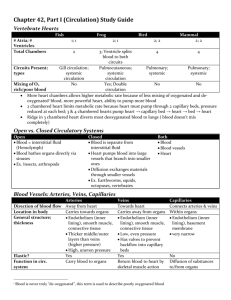handout
advertisement
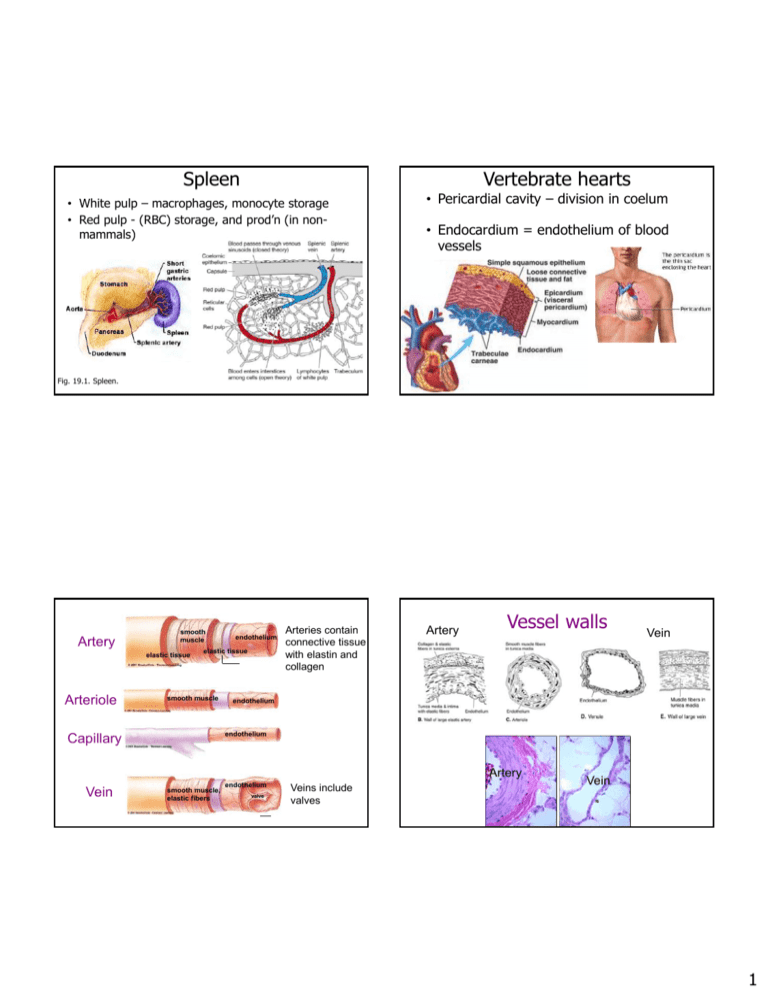
Spleen Vertebrate hearts • White pulp – macrophages, monocyte storage • Red pulp - (RBC) storage, and prod’n (in nonmammals) • Pericardial cavity – division in coelum • Endocardium = endothelium of blood vessels Fig. 19.1. Spleen. Artery smooth muscle elastic tissue Arteriole endothelium elastic tissue smooth muscle Arteries contain connective tissue with elastin and collagen Artery Vessel walls endothelium endothelium Capillary Artery Vein Vein smooth muscle, elastic fibers endothelium valve Veins include valves Vein 1 Veins Large arteries • Elastic recoil from arteries drives flow of blood during diastole Systole • Most of the blood volume is in venous system (60-70%) - resevoir • Blood volume is variable • Arteries temporarily expand and hold pumped blood Diastole Vertebrate circulation Vertebrate circulatory systems are either a single circuit (fish) or double circuit (tetrapods) Heart and vessel development p. 607 Early circulation - amphibian 26 day old human embryo Ventral aorta, aortic arches, dorsal aorta 2 Ancestral vertebrate pattern Dorsal Aorta Venous development Paired dorsal Aortae Internal Carotid 6 VI 5 V 4 IV 3 III 2 II 1 I • Sinous venosus, hepatic portal system Ventral Aorta Heart Fish circulation • Heart is below pharynx, near gills • 4 chambers in sequence • Stiff tissue around heart allow sinus venosus suction during diastole (no collapse) Fish circulation – Conus arteriosus – muscular, maintains pressure during diastole • Teleosts – bulbus arteriosus – enlarged elastic ventral aorta 3 Fish circulation Aortic arches In fish, the aortic arches (AA) are the afferent and efferent branchial arteries Aortic arches in tetrapods 3rd • AA – Carotid • 4th AA – Systemic arch (dorsal aorta many branches!) • 6th AA – Pulmonary arch Tetrapod hearts • Sinus venosus and conus arteriosis are lost/reduced – sinus venosus reduced to junction of vena cava and rt. atrium • Blood returns from two sources 4 Many tetrapods have incomplete separations • • • • Amphibians Dipnoi Ancestral crossopterygii Reptiles Lungfish aortic arches facing A fish with pulmonary circulation Often not using lungs! In other fish, swim bladders supplied from dorsal aorta Most blood in systemic Shunting a must Aquatic 2 3 4 5 6 On land Amphibian circulation Lungfish heart Has incomplete separation of both rt. & lt. atria; and rt. & lt. ventricles Yet two ‘streams’ are separate • Metamorphosis – heart moves towards lungs • AA’s are ‘traditional’ tetrapod: 3,4,6 (frog) O2 poor to 5th and 6th (back gills and lung). AA 3 and 4 O2 rich to 3rd and 4th. AA 5 and 6 Spiral valve in conus spiral valve Ventricle septum 5 Amphibian heart • Atria are completely divided, ventricle division is incomplete – Yet very little mixing occurs Amphibian heart • Ventricle has spongy pockets (trabeculae) • Trabeculae separate deoxy. and oxygenated blood in ventricle trabeculae trabeculae Frog heart Frog heart 6 Frog heart Frog heart Ventricle contraction Frog spiral valve • Spiral valve in conus arteriosus Ventral aorta shortened to truncus arteriosus Reptile circulation • Truncus arteriosus has three trunks LS RS P 7 Reptile heart • When not ventilating lungs, pulmonary resistance increases, blood is shunted from rt ventricle to lt systemic Reptile heart • High CO2, acidity causes Bohr effect and hemoglobin loses affinity for O2 sea snake Saturation curve shifts to the right Crocodilia heart • Ventricles divided • Crocodiles have foramen of Panizza connecting rt. and lf. systemic • Lf systemic can receive rt. ventricle blood Crocodilia heart • Using lungs valve higher pressure – Foramen of Panizza allows Ox. blood into left systemic Left to right shunt 8 Bird Crocodilia heart Mammal • Systemic arch is one-sided in endotherms lower pressure Cog • Diving– F. of P. allows mixed blood to flow into right systemic Right to left shunt p.618 Human heart development Adult mammal circulation One-way flow in early development 9 Amniote fetus circulation • Oxygenated blood to fetus coming from outside, not lungs – developing reptiles, birds, mammals Fetal circulation • Blood flows through umbilical vein, through ductus venosus to vena cava Fetal circulation • Most blood from lt atrium goes through foramen ovale to rt atrium 10 Fetal circulation • Meanwhile....some blood in right atrium goes instead to right ventricle Most right ventricle blood goes through ductus arteriosus to aorta Neonatal circulation At birth pulmonary pressure reduces below systemic Foramen ovale After a day or more: Ductus arteriosus Fossa ovalis Ligamentum arteriosum Neonatal problems Patent foramen ovale (20% of people) chest pressure causes flap to open, strokes Patent ductus arteriosus Heart can become enlarged 11 Portal systems Hepatic portal system • Newly absorbed compounds are brought to liver • With portal system: Veins branch again into capillaries portal vein • Conservative: found in all vertebrates Renal portal system • From hind limbs to kidney, resorbing portion of kidney circulation • All vertebrates except mammals 12
